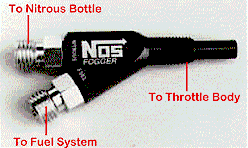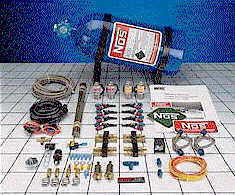![]()
Adding Nitrous Oxide (N2O) to your car, is one of the most cost effective ways to substantially increase your horsepower and torque. The power increases are phenomenal, it is available on demand, and a "normal system" will cost you thousands less than a turbo- or super-charger. The marvels of modern chemistry!
How does Nitrous Oxide accomplish this?
1. Nitrous Oxide is comprised of 36% oxygen as compared to about 21% that is in a normal atmospheric intake charge--that's about 70% more oxygen! More oxygen means more combustion which in turn means more power (assuming that there is sufficient fuel to burn the additional oxygen!)
2. So if greater oxygen and fuel content in the combustion chamber cause the increase in horsepower, why not just inject oxygen? Well, the engine would produce more power than it could handle and simply blow up! Once the N2O is injected into the chamber and the temperature reaches 572°F (on the power stroke), the molecules breakdown and the the nitrogen and oxygen molecules are separated. The oxygen is immediately burned and the remaining nitrogen helps to dampen the combustion so that the above problem does not occur.
3. As the Nitrous Oxide changes from a liquid to a gas, it cools the intake air temperature to the tune of 60°-75°F. As a rule of thumb, for every ten degree reduction in intake air temperature, there is a 1% increase in horsepower.
![]()
What types of nitrous oxide systems are available? The three basic types are the wet manifold, the dry manifold, and the direct port systems.
 In a wet
system, nitrous oxide and fuel mixed are at and then delivered
through a "fogger" which is directly threaded into the
throttle body (or intake tube). Steel braided lines are attached
to the N2O bottle and the fuel system and are opened and closed
via switching solenoids.
In a wet
system, nitrous oxide and fuel mixed are at and then delivered
through a "fogger" which is directly threaded into the
throttle body (or intake tube). Steel braided lines are attached
to the N2O bottle and the fuel system and are opened and closed
via switching solenoids.
Inside of the nozzle are "jets" which determine the amount of N2O sprayed into the engine. This is what actually determines the amount of "shot" that any given kit will produce. The larger the jet, the higher the horsepower output and vice versa.
The dry manifold system is similar to the wet system, however the fuel and nitrous oxide are NOT mixed at the fogger. The N2O is injected into dry air (without fuel) upstream in the manifold and it is then mixed with fuel at the injectors. Since this type of system has no real means of adding the additional fuel that is required to burn the extra oxygen, it should only be used for less than 70 hp shots with factory injectors.
 Direct-port systems are by far the best
for reliability and power, but are also the most expensive and
most difficult to install. This kit is basically a "wet
kit", but each cylinder getting its own fuel/nitrous nozzle.
The fogger injects the nitrous and fuel directly into that
cylinder's intake port. The installation of this type of kit
requires that the intake manifold be removed from the engine.
These kits offer the highest horsepower shots due to their ideal
N2O/fuel mixture at each cylinder. This would be the "must
have" kit for the serious strip racer.
Direct-port systems are by far the best
for reliability and power, but are also the most expensive and
most difficult to install. This kit is basically a "wet
kit", but each cylinder getting its own fuel/nitrous nozzle.
The fogger injects the nitrous and fuel directly into that
cylinder's intake port. The installation of this type of kit
requires that the intake manifold be removed from the engine.
These kits offer the highest horsepower shots due to their ideal
N2O/fuel mixture at each cylinder. This would be the "must
have" kit for the serious strip racer.
For a stock 2.5L Probe, I personally would not use more than a 75-80 HP dry kit and possibly a 90 HP wet manifold kit. For a stock 2.0L Probe, I wouldn't go any higher than a 40-50 HP shot dry or wet. Notice that I precluded both of those with STOCK. A general rule for determining which size shot to use is 40%-50% of the engine's factory horsepower rating. With ignition and fuel system upgrades the horsepower figures could be increased a little more.
I should note that wet kits (other than direct port) can cause fuel to puddle in the intake track and possibly cause severe backfire conditions. If you would like the added benefits of a wet kit, I would recommend spending the extra money on the direct port variety.
Misuse of N2O could cause serious damage to you and/or your engine. Be absolutely sure that you understand how and when to use the nitrous once it is installed on your car. Read the manuals, ask someone who is experienced with it, or call the manufacturer for specifics.
Here is a Nitrous Oxide FAQ that should answer most of the questions that you may have.
One of the most popular manufacturers of nitrous systems is NOS. Check out there site for more FAQs and their online catalog.
![]()
![]()
This site is made possible by Geocities.